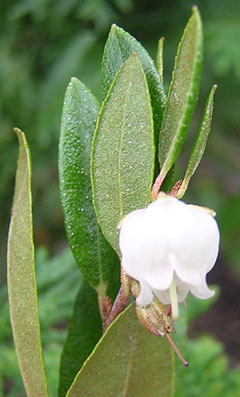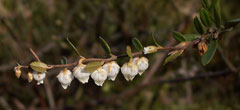 |
|
|
 |
| http://commons.wikimedia.org/wiki/User:B.gliwa |
Translate this page:
Summary
Physical Characteristics

 Chamaedaphne calyculata is an evergreen Shrub growing to 0.8 m (2ft 7in) by 1 m (3ft 3in).
Chamaedaphne calyculata is an evergreen Shrub growing to 0.8 m (2ft 7in) by 1 m (3ft 3in).
See above for USDA hardiness. It is hardy to UK zone 7. It is in leaf all year, in flower from April to June. The species is hermaphrodite (has both male and female organs) and is pollinated by Insects.
Suitable for: light (sandy), medium (loamy) and heavy (clay) soils and prefers well-drained soil. Suitable pH: mildly acid soils and can grow in very acid soils.
It can grow in semi-shade (light woodland) or no shade. It prefers moist soil.
UK Hardiness Map
US Hardiness Map
Synonyms
Andromeda calyculata.
Plant Habitats
Woodland Garden Dappled Shade; Shady Edge; Bog Garden;
Edible Uses
Edible Parts:
Edible Uses: Tea
An aromatic tea-like beverage is brewed from the fresh or dried leaves[161, 177, 183, 257]. Some reports say that boiling or steeping can extract a harmful toxin 'andromedotoxin' and it is recommended that the leaves are put in a jar of water and left in a sunny position to brew in order to make 'sun-tea'[183].
References More on Edible Uses
Medicinal Uses
Plants For A Future can not take any responsibility for any adverse effects from the use of plants. Always seek advice from a professional before using a plant medicinally.
Antiphlogistic Febrifuge
A poultice of the leaves has been applied to inflammations[257]. An infusion of the leaves has been used to treat fevers[257].
References More on Medicinal Uses
The Bookshop: Edible Plant Books
Our Latest books on Perennial Plants For Food Forests and Permaculture Gardens in paperback or digital formats.

Edible Tropical Plants
Food Forest Plants for Hotter Conditions: 250+ Plants For Tropical Food Forests & Permaculture Gardens.
More

Edible Temperate Plants
Plants for Your Food Forest: 500 Plants for Temperate Food Forests & Permaculture Gardens.
More

More Books
PFAF have eight books available in paperback and digital formats. Browse the shop for more information.
Shop Now
Other Uses
References More on Other Uses
Cultivation details
Thrives in a moist well-drained lime-free soil in sun or semi-shade[1, 200]. Best if given some protection from the midday sun[1]. Plants are hardy to about -25°c[184]. There are some named forms, selected for their ornamental value. 'Nana' is a dwarf compact form that is good for shady areas[183]. The flowers have a delicate refreshing scent[245].
References Carbon Farming Information and Carbon Sequestration Information
Temperature Converter
Type a value in the Celsius field to convert the value to Fahrenheit:
Fahrenheit:
The PFAF Bookshop
Plants For A Future have a number of books available in paperback and digital form. Book titles include Edible Plants, Edible Perennials, Edible Trees,Edible Shrubs, Woodland Gardening, and Temperate Food Forest Plants. Our new book is Food Forest Plants For Hotter Conditions (Tropical and Sub-Tropical).
Shop Now
Plant Propagation
Seed - sow February in a lime-free compost in a greenhouse and only just cover the seed[78]. Do not allow the compost to dry out and keep the pot in a shady position. Germination is usually fair, taking 1 - 12 months at 15°c, though 4 weeks cold stratification may reduce this time[164]. When they are large enough to handle, prick the seedlings out into individual pots and grow them on in a greenhouse for at least their first winter. Plant them out into their permanent positions in late spring or early summer, after the last expected frosts[164]. Cuttings of almost ripe side-shoots, 4 - 5cm long with a heel, August in a frame. A variable degree of success[78]. It can help to prune the plants lightly after flowering in order to encourage vigorous growth from which to take the cuttings[78]. Layering in August. Takes 18 months. High percentage[78].
Other Names
If available other names are mentioned here
Native Range
TEMPERATE ASIA: Russian Federation-Western Siberia (Western Siberia), Russian Federation-Eastern Siberia (Eastern Siberia), Russian Federation (Habarovskij kraj, Primorye, Amur, Kamcatskij kraj, Magadanskaja oblast, Sakhalin), China (Jilin Sheng, Liaoning Sheng, Nei Mongol Zizhiqu), Japan (Hokkaidô) NORTHERN AMERICA: Canada (Northwest Territories, Yukon, New Brunswick, Newfoundland and Labrador, Nova Scotia, Ontario, Prince Edward Island, Québec, Alberta, British Columbia, Manitoba, Saskatchewan), United States (Connecticut, Indiana, Maine, Massachusetts, Michigan, New Hampshire, New Jersey, New York, Ohio, Pennsylvania, Rhode Island, Vermont, Illinois, Minnesota, Wisconsin, Maryland, North Carolina, Virginia) EUROPE: Finland, Sweden, Poland, Russian Federation (European part), Belarus
Weed Potential
Right plant wrong place. We are currently updating this section.
Please note that a plant may be invasive in one area but may not in your area so it's worth checking.
Conservation Status
IUCN Red List of Threatened Plants Status :

Growth: S = slow M = medium F = fast. Soil: L = light (sandy) M = medium H = heavy (clay). pH: A = acid N = neutral B = basic (alkaline). Shade: F = full shade S = semi-shade N = no shade. Moisture: D = dry M = Moist We = wet Wa = water.
Now available:
Food Forest Plants for Mediterranean Conditions
350+ Perennial Plants For Mediterranean and Drier Food Forests and Permaculture Gardens.
[Paperback and eBook]
This is the third in Plants For A Future's series of plant guides for food forests tailored to
specific climate zones. Following volumes on temperate and tropical ecosystems, this book focuses
on species suited to Mediterranean conditions—regions with hot, dry summers and cool, wet winters,
often facing the added challenge of climate change.
Read More
Expert comment
Author
(L.)Moench.
Botanical References
1143200
Links / References
For a list of references used on this page please go here
Readers comment
| Add a comment |
|
If you have important information about this plant that may help other users please add a comment or link below. Only comments or links that are felt to be directly relevant to a plant will be included. If you think a comment/link or information contained on this page is inaccurate or misleading we would welcome your feedback at [email protected]. If you have questions about a plant please use the Forum on this website as we do not have the resources to answer questions ourselves.
* Please note: the comments by website users are not necessarily those held by PFAF and may give misleading or inaccurate information.
To leave a comment please Register or login here All comments need to be approved so will not appear immediately.
|
Subject : Chamaedaphne calyculata
|
|
|
|